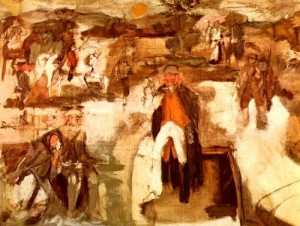
Ain’t that how it always goes? You have a couple of girls, shoot uncomfortable videos of them teenage and topless in the 1970s, and then, when you’re dead, they make their hatred of you well known.
So it goes, at least, with the late art-world star Larry Rivers, whose daughters, according to a lengthy Vanity Fair profile, have been frustrating his estate’s efforts to donate “Growing,” a documentary in which he behaved… questionably:
Like Andy Warhol, Rivers saw video as a new art form. Unlike Warhol, he used it mainly to explore sexual taboos. In 1976 he had Gwynne, then 11, participate in a film called Growing by baring her breasts before the camera and discussing how she felt about them. He also filmed Gwynne nude in his shower and had her slip topless between the black satin sheets of his bed. A year and a half later, Emma was conscripted, too.
Twice a year for four more years, the daughters submitted to filming sessions, sometimes just with their breasts exposed, sometimes naked, as their father asked them questions about their bodies and budding sexuality. In the early 1980s, Growing was edited, and screen credits were added; Rivers planned to play it in a continuous loop at a show of his paintings. Dissuaded by Clarice, the girls’ mother, from doing that, he put the film and its outtakes on a shelf, to be forgotten by almost everyone—except Emma and Gwynne.
The article explores this conflict from almost every angle, but it’s hard (for me) to know how to make up my mind. Did Rivers exhibit bad judgment? Uh, yes. Was he a child pornographer? Hm, depends who you ask. Should “Growing” itself be destroyed? Uh…
What does emerge from the story is a portrait of an extremely messy family: ex-wives and girlfriends, gay lovers and enemas with the in-laws, sibling rivalries and gender dynamics. Is Emma, who married her dad’s physical trainer, a man 20 years older than her, righteously angry, or neurotic? Are Rivers’s sons, who also featured in his nude portraits, oblivious to how it’s maybe different for girls?
Within the family, I imagine, this all makes a lot more sense. There are shared histories, alliances forged at the breakfast table and hostilities vented in the backyards and expansive Central Park West apartments. The Vanity Fair article may go into great depth about the Rivers clan’s current squabbles, but it inevitably simplifies: Seen from the outside, the family just isn’t—can’t be—what it seems to be from the inside.
Which is perhaps a good lesson for all of us. The light of day, the eyes of our neighbors, and the cold probing hands of the courts have a way of turning in-jokes into assault and subtle dynamics into digestibly binary oppositions. Don’t trust anyone—least of all your own kids.

Seriously? I knew the answer within the first few paragraphs of that story. Person who’s image it is that is portrayed, pre-adulthood, trumps all. She and her sister decide. They, and only they together, get to decide if all copies should be destroyed or if they get to do their own art to work out their daemons.
Regardless of the art vs. porno vs. pedophilia vs. schlock, the images belong to the two women who’s development years were recorded.